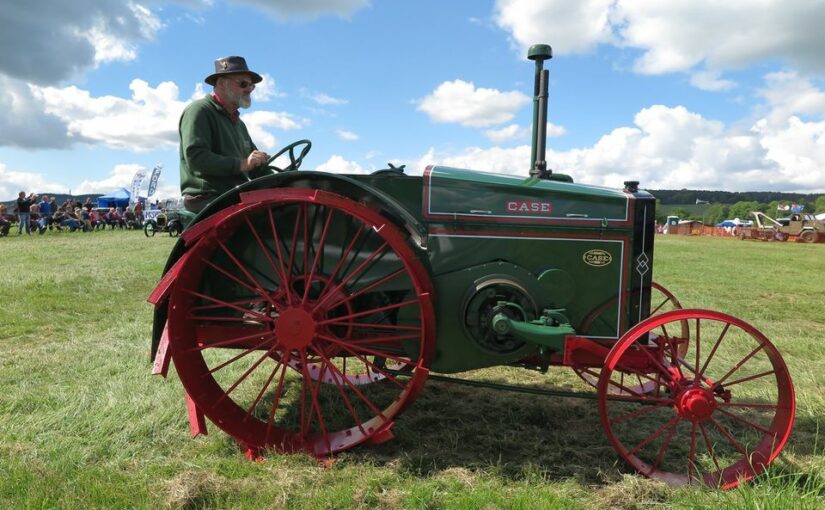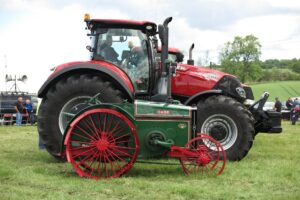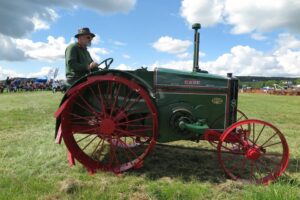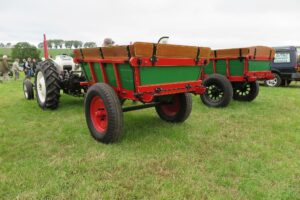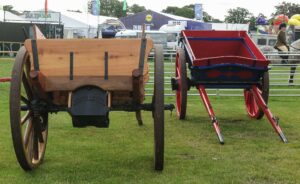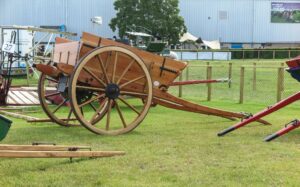American implements and machines have had a long impact on Scottish agriculture. It is not always easy to quantify that impact. The Scotsman included an interesting article in its columns on 3 October 1903 from the perspective of the American makers who were looking to the Scottish markets and to state what had been achieved by the American makers. While the start of the article provides a general account of Scottish agriculture, the latter parts include some interesting details about how the American makers looked at Scotland and the changes they had to make to their machines so that they could operate efficiently here. It also includes some details about how extensive the use of American machinery was in Scotland. Here is the article at full length:
“At the request of the American National Association of Agricultural Implement and Vehicle Manufacturers, a circular was addressed by the Department of State, on April 17, 1903, to the consular officers in the various countries instructing them to procure certain information as to the trade in agricultural implements and vehicles in their several districts, especially as to the share of American manufacturers therein and the best methods for the increase of the same.
Agriculture in Scotland
Mr Rufus Fleming, Edinburgh, in his report details at the outset with the characteristics of agriculture in Scotland. Speaking broadly, he says, all kinds of agricultural machines and implements suited to the requirements of the soils, crops, and climate are used by the farmers of Scotland. With few exceptions, these implements are of modern pattern; in fact, fully up-to-date in design, quality, and utility. As in preparing the soil and drilling or sowing the grain and grass crops, so in harvesting these crops, the most improved and economical machines are required, not only because they are labour saving, but also because it is necessary to successful agriculture in this country, both to make the land produce as much as possible and to gather the crop clean, almost to the last straw or blade. Most farmers, in the Lowlands at least, grow great crops of wheat, barley, oats, and other grains; a yield of 60 bushels of wheat per acre is not uncommon, and of barley from 50 to 60 bushels, while high cultivation brings as much as 80 bushels per acre of the latter. They must do it in order to make their holdings profitable, as the prices of grain are regulated by the American market, and the rent of the land is generally high, and to the same end they must utilize fully the products of the soil. For this purpose they require every practicable mechanical aid.
Farm labour
To what extent the cost of labour has influenced farmers to provide themselves with the best implements is a question to which it is not easy to find an answer. Undoubtedly the scarcity and unreliability of farm labourers have had something to do in this direction. It is a curious fact that in an over-populated country-I speak of the United Kingdom as a whole-the demand for farm labourers is always greater than the supply. The conditions of country life in Scotland for the labourer are not as severe as they were some years ago. Yet there is more discontent among the farm hands in the various trades in the cities or among the urban day-labourers. As soon as they accumulate a little money they emigrate, many of them to become prosperous farmers in the United States or Canada. I have talked with farm hands on this subject and found that it is the hopelessness of the struggle in which they are engaged that makes them discontented. By no possible thrift or effort of their own can they ever acquire title to or possession of a foot of ground, and they are always looking forward to the day when they can go to the United States or a British colony and get an opportunity to work for themselves.
Markets for implements
Scotland has an area of 19,062,482 acres, of which 4,894,466 acres are under cultivation; 112 persons own one-half of the total area, and 18 persons own one-fourth of it. It is quite apparent, therefore, that most of the farmers are occupiers under lease. The common terms of leases are fifteen and nineteen years. Special returns giving the number and size of agricultural holdings-i.e., all holdings of leased land and of land owned by the occupiers-were last collected by the Board of Agriculture in 1895. At that time the number and acreage of such holdings of cultivated land, as distinct from mountain grazings, were as follows-
Number of holdings
1 to 5 acres – 20,150
5 to 20 acres – 23,104
20 to 50 acres – 10,817
50 to 100 acres – 9,834
100 to 300 acres – 12,958
300 to 500 acres – 2070
500 to 1000 acres – 620
Over 1000 acres – 75
As compared with the returns collected in 1885, these statistics showed little change, and it is probable that if these statistics were gathererable this year they would not differ materially from the above. These figures furnish the best obtainable basis for an estimate of the possibilities of Scotland as a market for agricultural implements.
American farm implements
American farm implements have been in use in Scotland for twenty-five or thirty years-not all classes, but the practical ones. Some of our manufacturers, when they were ready for the foreign trade, studied the requirements of the British market, and adapted their contrivances to conditions in this country. In a report on this subject in 1898. I said-
When the binder was invented it commended itself at once as a labour-saving device, but it encountered difficulties in Scottish fields. There is here a heavier stand of grain than in most parts of the United States. Moreover, the farmers sow grass seed with the barley. This grass is exceedingly fine and also dense. The new reaper was a failure at first, owing chiefly to the fact that the undergrowth of grass in the barley interfered with its working. The blade of the machine was too light, and the canvases were not properly adjusted. No sooner were these defects-from a Scottish point of view-ascertained than a heavier blade was introduced and the canvasses were altered. In less than two years the American binder was an established favourite; it still holds the market. The chilled plough was not at first suited to the needs of Scottish farmers. They prefer a narrow furrow and do not deem it a good plan to turn the furrow over; they wish, rather, to set it on edge. The plough was changed to meet their ideas as to the proper way to turn up the ground, and the result was that the American plough has gained almost universal favour. American farm machinery of almost every description has had to be altered in some important respects to adapt it to the different conditions found here. Most manufacturers have been quick to make the necessary changes, and their enterprise has been abundantly rewarded. It is my information, derived from interviews with the managers of the most prominent local firms in the trade, that at the present time 70 per cent of the binders, 75 per cent of the mowers, 25 per cent of the hay rakes, from 60 to 70 per cent of the ploughs, and about 70 per cent of the cultivators and grain drills in use in Scotland were manufactured in the United States. It is said that 20 per cent of the binders are Canadian and 10 per cent English. The estimate here given of the proportion of American ploughs is confided to farms of upwards of 100 acres. On smaller holdings many of the ploughs are of local manufacture; they are made in the shops of village blacksmiths, as well as by implement manufacturers in the cities and larger towns. Our chilled ploughs are, however, constantly growing in favour, and the market for them is an expanding one. Only walking ploughs are in demand, with one wheel to the beam as a rule. The gang plough is so seldom wanted that it can hardly become a commercial item of great importance in this country. The steam ploughs and cultivators used on a few big farms are, it is said, all made in England, as well as the engines, cables, &c. In plough parts the American manufacturers have practically all the trade. This is true also of hayforks. Hoes are largely English made to American patterns; our makers do not compete in prices, although the handles are imported from America by the Sheffield manufacturers. Our hay knives have a good sale; also our snaths and handles in general. Few American harrows are sold here, as the makers have not I am told adapted to the deep cultivation required; nor ate many of our rollers imported. Our thrashing machines are not used, being regarded as too light to throw off the extraordinary weight of straw and grass in Scottish grains. According to one Edinburgh dealer, farmers are now finding fault with some patterns of American cultivators, claiming that they do not go deep enough; but, so far as I can ascertain from other sources, the tendency of trade does nor show that they have fallen out of favour. The grubber is an important implement in Scotland for tearing up the ground to any depth required. They are used on every farm, and are, I believe, all of local manufacture. Potato diggers are of Scottish and English maker. It is said by growers that the rotary-arm digger, commonly used damages the potatoes, especially the early and tender varieties: they are more satisfactory than the potato plow, but the growers are looking out for something better. Any suitable device that will not bruise the potatoes, will, if offered at a moderate price, find a good market here. Wind-mills for pumping water for stock, &c, are not as common in Scotland as in England. Streams are numerous, and, with an abundant rainfall throughout the year (often superabundant), provide an ample supply of water for general purposes on the majority of farms. I am told that most of the windmills as well as the hand pumps in use are of American manufacture; this may be too large a statement, but it is not far wrong. Our standard pumping devices have an excellent reputation and a wide sale.
Building up American trade
During the last decade the competition among manufacturers of agricultural implements for the trade in this part of the United Kingdom has been active, especially so during the past years. The principal American makers of harvesting machines, &c, have pushed their business vigorously in rivalry with one another, and with Canadian and British companies. They sent expert sales man to assist their local agents in reaching out for trade, these salesmen making a farm to farm canvass of the country. The figures above given show that the sales have been large, and as a binder or mower in the hands of a careful Scottish farmer lasts a long time, there is now a slackness in the trade. The demand is moderate, with a downward tendency in prices. Canadian firms are exceedingly persistent and energetic. They are a factor in the problem of trade in these islands in the future which American manufacturers will have to reckon with. While our agricultural apparatus of all kinds are, as a rule, superior to the Canadian, and have gained a leading position for that reason, cheapness is likely to be in most cases when competing articles are offered the determining quantity in the commercial equation, and therefore it is only by continuing to meet the prices of all competitors that our manufacturers can maintain their supremacy in this market.
Farm vehicles
American farm waggons or carts are not sold here in any considerable number. The carts are mainly of local manufacture, being made in almost every city and village. Requiring no skilled workmanship, they are constructed cheaply, with a sole view to utility. My information is that the only reason why carts of American make are not used in Scotland is that a similar article has not been offered at the same price, A prominent dealer in farm machinery, supplies, &c, tells me that when in America a few years ago he asked the manager of a great wagon-making concern if he could manufacture farm carts for Scotland at a price which would give them a market in competition with the local makers, the manager expressed the opinion that it could not be done. On returning home this dealer sent to the American company a Scottish cart and also a lorry (used for hauling goods to and from railway freight depots), giving prices &c. Not long afterwards a letter came from the manager saying that he had figured as closely as possible on the cart and lorry proposition, and could not work out a margin of profit after adding freight. The freight charge put it just above the level of the practicable.
How to increase American trade
In regard to the most effective means of increasing the same of implements and other farm supplies, I can only suggest that the best results are likely to be obtained by the efforts of experienced American salesmen, actively co-operating with local agents in pushing trade. One good method of bringing articles to the attention of the farming community has been neglected on too many occasions by our manufacturers or their representatives on this side; I refer to exhibits at agricultural shows. These shows, general and local, are frequent in Scotland during the year and are attended by the alert, progressive farmers. Any machine, implement, or vehicle exhibited in an attractive way is well advertised, and if it has exceptional merits they will not be overlooked. A number of American concerns have taken advantage of the larger shows and now and then a minor exhibition; but if any firm or any association of implement manufacturers would make a thorough commercial campaign in this country, they should lose none of these opportunities to reach the enterprising class of agriculturists. As an agent remarked to me half a dozen implements sold to prominent farmers at such places will sell hundreds more. This has been his observation, and he is a strong advocate of exhibits at county shows and even less important occasions.”
